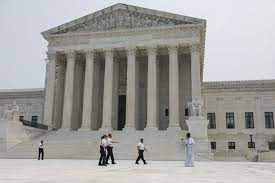Ruth Marcus
Back then, the court’s rush to intervene in the 2000 Florida recount stained its reputation, making it look like just another political actor in effectively awarding the presidency to George W. Bush. But, unlike Bush v. Gore, the Supreme Court should take this case, which Trump has already announced he will appeal. Yes, once again, whatever the justices do will be interpreted through the distorting lens of partisanship.
A decision that allows Trump to remain a candidate despite his role in the Jan. 6, 2021, insurrection – the most likely result, in my view – will be derided as the work of “partisan hacks,” to use Justice Amy Coney Barrett’s resonant phrase, siding with the party that appointed them. That skepticism would be understandable, given the record of this court’s aggressive conservative majority. But it would also be wrong, because Section 3 of the 14th Amendment should not be used to prevent Americans from voting to elect the candidate of their choice. The best outcome, for the court and the country, would be for a unanimous court – preferably an 8-0 court with Justice Clarence Thomas recusing himself – to clear the way for Trump to run.
To back up, Section 3 of the 14th Amendment provides that “no person shall … hold any office, civil or military, under the United States … who, having previously taken an oath, as a member of Congress, or as an officer of the United States … to support the Constitution of the United States, shall have engaged in insurrection or rebellion against the same, or given aid or comfort to the enemies thereof.” Unlike the rest of the 14th Amendment, this post-Civil War provision, aimed at former Confederate officials, has been little used, then or in subsequent years. But Jan. 6, 2021, revived attention to the once-obscure provision, and challenges under Section 3 have been filed in multiple states.
On Tuesday, the Colorado Supreme Court found that Section 3 applies to Trump and therefore bars him from appearing on the state’s March 5 presidential primary ballot. The court divided 4-3; all seven justices were appointed by Democratic governors. A lower court had found that Trump engaged in insurrection but was not covered by Section 3 based on an implausible reading under which “officer of the United States” did not include the president. It defies logic to believe that the framers of the amendment meant to exclude former Confederate soldiers from all offices but the most important, and the Colorado Supreme Court was correct to disagree with this interpretation.
“President Trump asks us to hold that Section Three disqualifies every oath-breaking insurrectionist except the most powerful one and that it bars oath-breakers from virtually every office, both state and federal, except the highest one in the land,” the majority wrote. “Both results are inconsistent with the plain language and history of Section Three.” But the majority agreed with the lower court that Trump’s conduct amounted to engaging in insurrection under Section 3. “President Trump did not merely incite the insurrection,” it said. “Even when the siege on the Capitol was fully underway, he continued to support it by repeatedly demanding that Vice President Pence refuse to perform his constitutional duty and by calling Senators to persuade them to stop the counting of electoral votes. These actions constituted overt, voluntary, and direct participation in the insurrection.”
The three dissenting justices each wrote separately. The most interesting came from Justice Carlos Samour Jr., who said barring Trump from the ballot without legislation from Congress implementing Section 3 violates Trump’s due process rights, especially because Trump has not been charged with insurrection. “More broadly, I am disturbed about the potential chaos wrought by an imprudent, unconstitutional, and standardless system in which each state gets to adjudicate Section Three disqualification cases on an ad hoc basis,” Samour wrote. “Surely, this enlargement of state power is antithetical to the framers’ intent.”
Chaos indeed, which is why the high court needs to step in. Beyond what I think is the unconvincing avenue of text-parsing arguments about the meanings of “office” and “officer,” the justices have two major potential off-ramps at their disposal. One – and this would be my preference – involves the question Samour raised: whether Section 3 is self-executing. Here, the justices have the benefit of a decision by Chief Justice Salmon P. Chase in 1869 – the year after the 14th Amendment was ratified – that Section 3 requires enabling legislation.
In that case, from the days when justices rode the circuit, Chase ruled in the case of a formerly enslaved Black man who argued that his conviction for assault was void because the presiding judge had served in the Confederacy and was therefore disqualified from holding judicial office. Chase found that “legislation by Congress is necessary to give effect to the prohibition, by providing for such removal.” A second, more troubling, avenue would be for the justices to conclude, in opposition to the Colorado Supreme Court, that Trump’s speech is protected by the First Amendment and therefore cannot be punished as insurrection. In the seminal 1969 case, Brandenburg v. Ohio, the court said that “mere advocacy” of violence can’t be punished “except where such advocacy is directed to inciting or producing imminent lawless action and is likely to incite or produce such action.” Trump would surely seize on any such finding as vindication for his appalling behavior, which makes the Chase solution a better alternative.
But there is no world in which the justices are going to empower states to throw Trump off their ballots. Given that, the court should keep in mind: This is a moment it should aspire to be the unanimous court of Brown v. Board of Education, not the splintered, party-line body of Bush v. Gore. On that score, it was fitting that the Colorado court’s ruling arrived on the day of the memorial service for Justice Sandra Day O’Connor, who was reliably reported to have regretted her vote with the Bush v. Gore majority. “Probably the Supreme Court added to the problem at the end of the day,” O’Connor told the Chicago Tribune in 2013. That is a good test for the current court. Will its eventual ruling – and one seems unavoidable – add to the problem or help resolve it?
The Washington Post







